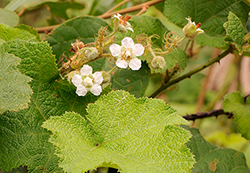e-Flora of Thailand
Volume 2 > Part 1 > Year 1970 > Page 55 > Rosaceae > Rubus
12. Rubus alceifolius Poir.wfo-0001018060
in Lam., Enc. 6: 247. 1804; Focke, Biblioth. Bot. 17(72): 78. f. 29. 1910; Craib, Fl. Siam. En. 1: 568. 1931; Roy. For. Dep., Siam. Pl. Names: 419. 1948; Thuan in Fl. C.L.V. 7: 49. pl. 3. 1968.
Accepted Name : This is currently accepted.
Synonyms & Citations :
Description : Erect or clambering shrub. Branches angled, yellow–tomentose, covered with curved prickles and sometimes glandular hairs. Leaves simple broad ovate or orbicular, obtusely 3–7-lobed, thick, 5–20 by 3–15 cm, usually deeply cordate, irregularly serrate, rugose above, tomentose underneath; nerves 5 pair, pubescent. Petiole 2–5 cm. Stipules joined to the stem, stipule segments capillary. Flowers 1.5–2 cm across, in axillary or contracted terminal panicles 18 cm long. Bract segments capillary. Pedicel 5–10 mm, reddish-setose. Calyx urceolate, fulvous-hairy; lobes lanceolate, tomentose. Petals obovate, white, glabrous, incised. Stamens numerous; anthers hairy at the apex. Carpels ca 30. Styles filiform, longer than the stamens; stigma flattened. Fruit globose, succulent. Stones rugose.
Thailand : NORTHERN: Chiang Mai, Chiang Rai, Lampang, Tak (Ban Musoe); NORTH-EASTERN: Nong Khai; SOUTH-EASTERN: Chanthaburi; SOUTH-WESTERN: Phetchaburi; PENINSULAR: Nakhon Si Thammarat (Thung Song), Surat Thani (Khlong Pan).
Distribution : Burma, Laos, Vietnam, Cambodia, China, Japan, Indonesia (Java – type), the Philippines.
Ecology : In open places at high and low altitudes.
Vernacular : Mahu khai pu (มะฮู้ไข่ปู)(Northern), fa lape (ฟ้าแลบ)(Peninsular).
Uses: Fruit edible. An infusion of the leaves is used as tea.

